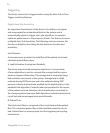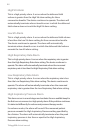Chapter 3 Modes, Features, and Alarms
41
BTPS Compensation
All ows and volumes used in Trilogy are expressed in BTPS - Body
Temperature atmospheric Pressure Saturated with H
2
O.
All pressures are expressed relative to atmospheric pressure.
Ventilator Alarms
This section describes all of the ventilator alarms and informational
messages in order of priority, from high priority alarms to low priority
alarms and nally informational messages. Refer to Chapter 6 for
more information on alarms.
Loss of Power Alarm
This is a high priority alarm. It may occur when a complete power
failure has occurred and power was lost while the device was
providing therapy. This may happen if the internal battery was the
only power source in use and was completely depleted.
Ventilator Inoperative Alarm
This is a high priority alarm. It occurs when the ventilator detects an
internal error or a condition that may aect therapy. The device will
shut down if the cause of the failure indicates that the device cannot
deliver therapy safely. If the device can deliver therapy at a limited
level, the device will continue to deliver limited therapy.
Ventilator Service Required Alarm
This is a high priority alarm. It occurs when the device cannot
perform to specication, a backup safety feature is compromised,
or the delivery of therapy is compromised. The device continues to
operate (possibly in a reduced capacity mode). If the problem is not
corrected, the device will generate a reminder message once per
hour until the issue is corrected. Additionally, if therapy is stopped, a
reminder message will immediately appear when therapy is turned
on again.


















